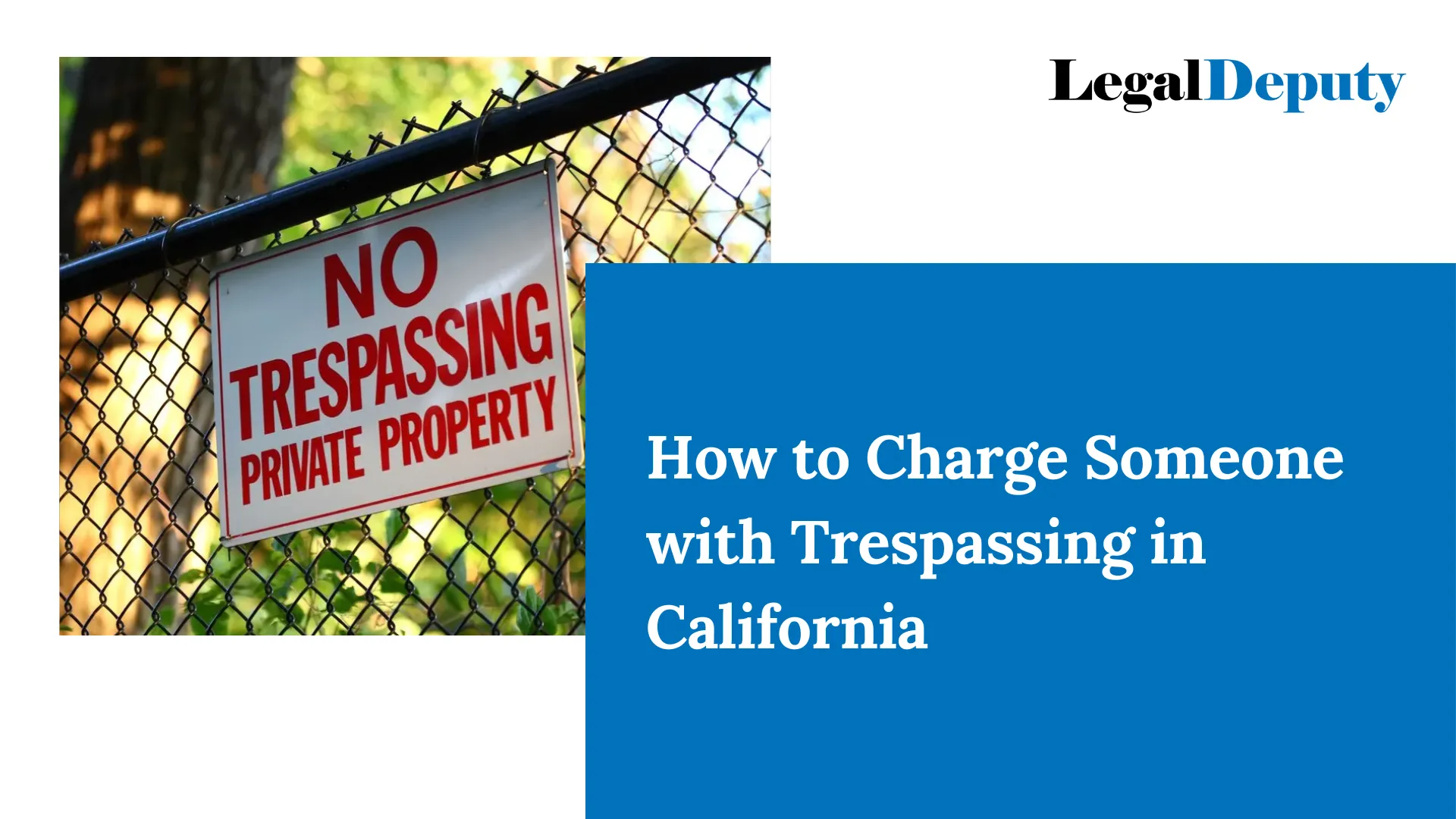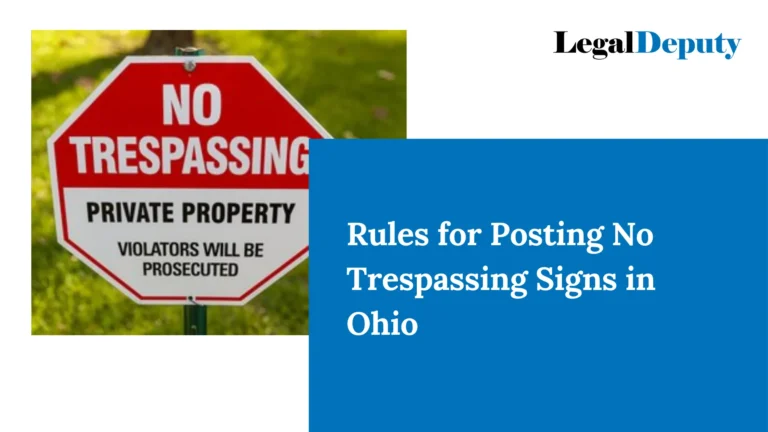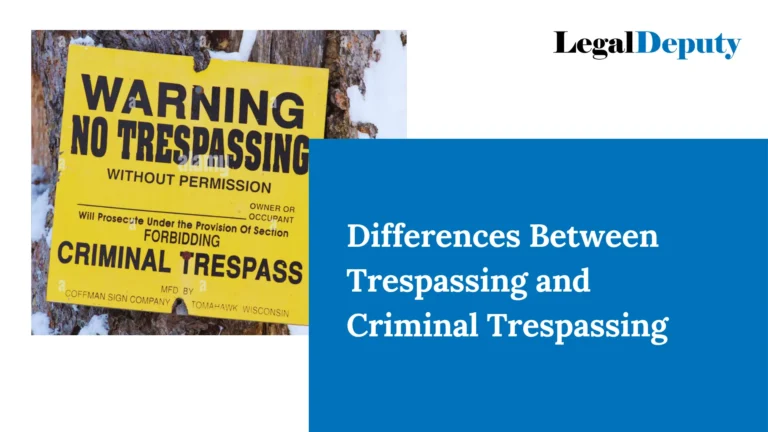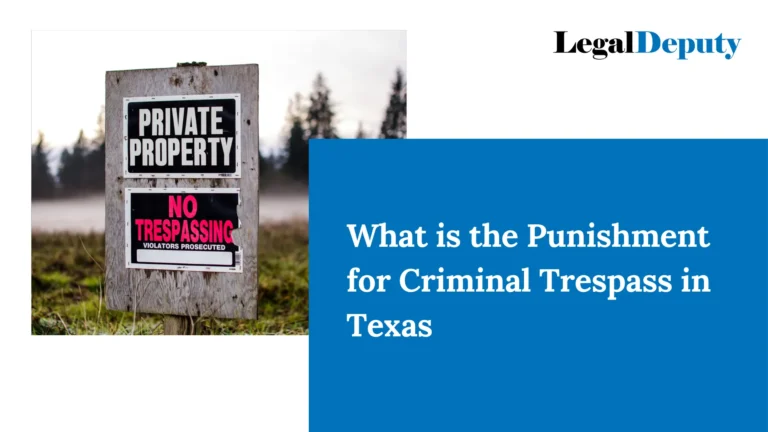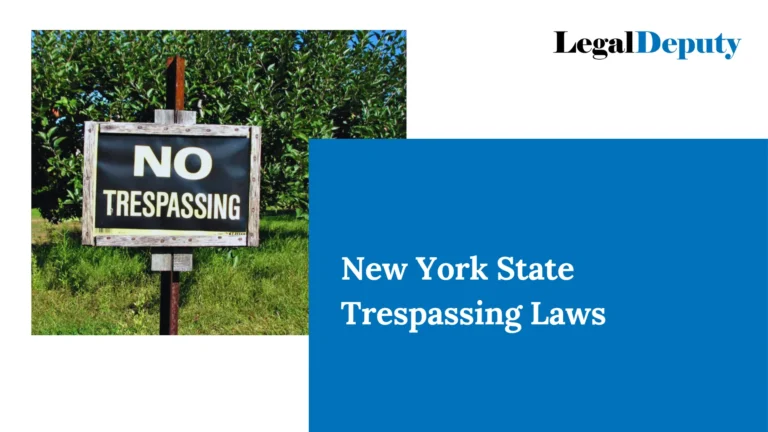How to Charge Someone with Trespassing in California?
Have you ever found yourself wondering about the boundaries of your property and the legal rights associated with it? Trespassing is a complex issue that, when not addressed properly, can lead to serious consequences.
Whether you’re a homeowner, a business owner, or simply someone concerned about property rights, understanding how to charge someone with trespassing in California is crucial. In this guide, we’ll walk you through the intricacies of California’s trespassing laws, shedding light on the process, key elements, and the importance of gathering the right evidence.
Join us on this journey to legal clarity, where we demystify trespassing charges and empower you with the knowledge needed to protect what’s rightfully yours. Let’s explore the intricacies of the law and navigate the path to justice together.
Understanding Trespassing Laws in California
California’s trespassing laws are designed to protect property owners and occupants, ensuring that individuals can enjoy their spaces without unauthorized interference. To navigate these laws effectively, it’s crucial to comprehend the various types of trespassing offenses and the elements that constitute them.
Types of Trespassing Offenses:
1. Simple Trespass: This is the most common form of trespassing, involving the unauthorized entry onto someone else’s property without permission. Simple trespass is generally considered a misdemeanor.
2. Aggravated Trespass: When trespassing involves additional criminal activities or escalates to harassment, it may be classified as aggravated trespass, potentially resulting in more severe consequences.
3. Criminal Trespass: Occurs when an individual enters a property with the intent to commit a crime. This offense is treated more seriously than simple trespass and may lead to felony charges.
Elements of Trespassing:
Understanding the elements that constitute trespassing is fundamental to identifying and proving a trespassing offense. Key components include:
1. Entry Without Permission: Trespassing hinges on entering a property without the owner’s or occupant’s consent. This could involve physical entry onto land, crossing boundaries, or refusing to leave when asked.
2. Intent: Intent plays a crucial role in trespassing charges. The individual must knowingly enter the property without permission. Accidental or unintentional entry may not meet the criteria for a trespassing offense.
3. Knowledge of Trespass: For a trespassing charge to hold, it must be established that the accused was aware they were entering private property without authorization.
4. Lawful Entry Revoked: Even if permission was initially granted, trespassing charges may apply if the property owner or lawful occupant revokes that permission, and the individual fails to leave.
In California, these elements form the basis for trespassing charges, and understanding them is paramount for both property owners seeking protection and individuals accused of trespassing. As we delve deeper into the intricacies of these laws, we’ll explore how to navigate potential trespassing situations and ensure justice prevails.
Property Rights and Trespassing: Safeguarding Spaces in California
In the picturesque landscapes of California, property rights hold significant importance, forming the bedrock of a homeowner’s or business owner’s sense of security. Understanding how property ownership intertwines with trespassing laws is key to navigating the legal landscape and preserving the sanctity of personal spaces.
The Significance of Property Rights in California:
Property rights are not just legal concepts; they are the cornerstone of personal freedom and privacy. In California, individuals have the right to control and enjoy their properties without unwarranted intrusion. This includes the right to decide who can enter their land, occupy their spaces, or engage in activities on their premises.
How Property Ownership Affects Trespassing Charges:
1. Boundaries and Ownership Limits: Property ownership establishes clear boundaries, demarcating the extent of an individual’s legal control. Understanding these boundaries is crucial for both property owners seeking protection and those accused of trespassing.
2. Authority to Grant or Deny Access: Property owners have the authority to grant or deny access to their premises. If someone enters without permission, it may constitute trespassing, especially if the owner expressly revoked access or if the individual’s presence violates established boundaries.
3. Defining Degrees of Trespassing: The degree of trespassing charges may vary based on the nature of the property and the actions of the accused. Residential trespassing may have different legal consequences compared to trespassing on commercial properties or open land.
Humanizing the Impact:
Consider the scenario of a family that has invested time, effort, and emotions into creating a home. The security and tranquility they derive from their property are deeply personal. Trespassing, in this context, is not merely a legal violation; it’s an intrusion into the very fabric of their daily lives.
Understanding property rights and how they intertwine with trespassing laws is not just a legal necessity but a means of safeguarding the places we call home. In the subsequent sections, we’ll delve into the specifics of California’s trespassing laws, offering insights into how property owners can protect their spaces and how individuals accused of trespassing can navigate these intricate legal waters.
Types of Trespassing Offenses: Navigating Degrees in California
Trespassing offenses in California vary in severity, each carrying its own set of legal consequences. Understanding these degrees of trespassing is crucial for both property owners seeking protection and individuals navigating potential legal challenges.
1. Simple Trespass (Misdemeanor):
Simple trespass is the most common form, typically classified as a misdemeanor. This offense occurs when an individual enters another person’s property without permission. Imagine a scenario where someone unknowingly wanders onto private land while hiking through unintentional, it could still be considered simple trespass.
2. Aggravated Trespass (Misdemeanor/Felony):
Aggravated trespass involves additional criminal activities or escalates to harassment. This offense may be classified as either a misdemeanor or a felony, depending on the severity. An example could be repeated unauthorized entries onto a property with the intent to intimidate or cause fear.
3. Criminal Trespass (Felony):
Criminal trespass is a more serious offense, typically classified as a felony. It occurs when an individual enters a property with the intent to commit a crime. For instance, if someone breaks into a building with the intention of theft or vandalism, they may face criminal trespass charges.
Humanizing the Impact:
Consider the case of a small business owner who discovers someone repeatedly entering their store after hours, causing both financial losses and emotional distress. In such instances, the consequences of trespassing extend beyond legal ramifications; they directly impact the livelihoods and well-being of those affected.
Understanding the nuances between misdemeanor and felony trespassing is vital, as it directly influences the severity of legal repercussions. As we delve deeper into the intricacies of each trespassing offense, we aim to provide clarity on how these laws operate in California, empowering you to make informed decisions and protect your property.
Elements of a Trespassing Charge: Unraveling the Legal Tapestry
Charging someone with trespassing in California requires a careful examination of specific elements that form the foundation of these legal proceedings. Understanding these key factors is not just a legal necessity but a pathway to justice for property owners and individuals accused of trespassing.
1. Entry Without Permission:
The fundamental element of a trespassing charge lies in an individual entering a property without the owner’s or occupant’s consent. This could involve physical entry onto land, crossing boundaries, or refusing to leave when asked. In essence, it’s about respecting the sanctity of personal spaces.
2. Intent:
Intent plays a pivotal role in determining the severity of a trespassing charge. Was the entry intentional? Did the individual knowingly violate the property boundaries? Establishing intent is critical for the legal system to differentiate between accidental entry and deliberate trespassing.
3. Knowledge of Trespass:
For a trespassing charge to hold, it must be established that the accused was aware they were entering private property without authorization. This element delves into the mental state of the individual at the time of entry, emphasizing the importance of proving consciousness of the act.
4. Lawful Entry Revoked:
Even if permission was initially granted, trespassing charges may apply if the property owner or lawful occupant revokes that permission, and the individual fails to leave. This element reinforces the concept that property owners hold the right to control access to their spaces.
Humanizing the Impact:
Consider the emotional toll on a homeowner who, after explicitly revoking permission for someone to be on their property, finds them lingering. The violation extends beyond physical boundaries; it breaches the trust and security that one should feel within their own abode.
Understanding the intricacies of these elements is not merely a legal exercise but a means of safeguarding the sense of security that property ownership affords. In the following sections, we’ll explore how these elements come into play in real-life situations, providing insights that can guide both property owners and those facing trespassing allegations.
Gathering Evidence: A Strategic Approach to Trespassing Cases
When facing a trespassing situation in California, solid evidence is your strongest ally. From documenting incidents to preserving crucial details, the evidence you gather can play a decisive role in supporting a trespassing charge. Let’s explore a strategic approach to evidence collection that combines legal efficacy with a human touch.
1. Document the Incident:
Start by documenting the trespassing incident thoroughly. This includes noting the date, time, and location of the occurrence. Describe the actions of the individual involved, emphasizing any verbal exchanges or warnings given. The goal is to create a comprehensive account that paints a vivid picture of the events.
2. Capture Photographs and Videos:
A picture is worth a thousand words, and in legal matters, it can speak volumes. Use your smartphone or camera to capture photographs and videos of the trespasser, their actions, and any damage caused. Visual evidence can be compelling in establishing the facts of the case.
3. Preserve Physical Evidence:
If there are items left behind by the trespasser, such as tools, belongings, or any signs of disturbance, preserve them carefully. Physical evidence can serve as a tangible link between the individual and the trespassing incident.
4. Obtain Witness Statements:
If there were witnesses to the trespassing, gather statements from them. Witness accounts can provide additional perspectives and strengthen your case. Ensure that witnesses include their contact information, making it easier for legal authorities to follow up if necessary.
5. Keep a Trespassing Log:
Maintain a detailed log of all trespassing incidents. Include the specifics of each occurrence, any communication with the trespasser, and actions taken to address the situation. This log can serve as a chronological record, aiding in demonstrating patterns of behavior.
Humanizing the Process:
Consider the emotional toll on a business owner who discovers repeated acts of trespassing, impacting not just their property but also their livelihood. The evidence-gathering process becomes a crucial step toward reclaiming a sense of security and stability.
In the next sections, we’ll delve into how this evidence can be presented effectively in legal contexts, offering insights on reporting trespassing incidents and collaborating with law enforcement. By combining legal strategies with a human touch, we aim to empower individuals to navigate trespassing cases with confidence.
Reporting Trespassing Incidents: Empowering Your Legal Journey
When faced with trespassing incidents, engaging with law enforcement is a crucial step towards resolution. Reporting these incidents not only ensures a timely response but also creates a formal record that can be vital in legal proceedings. Here’s a guide on how to navigate the process effectively, merging legal insights with a human touch.
1. Contacting Law Enforcement:
Emergency vs. Non-Emergency: If the trespassing incident is in progress or poses an immediate threat, dial emergency services. For non-emergencies, contact your local police department’s non-emergency line. Provide a clear, concise overview of the situation.
Provide Details: Clearly communicate that you want to report a trespassing incident. Be prepared to provide your name, location, and a brief description of the trespasser’s actions.
2. Details to Include in a Police Report:
Description of Trespasser: Provide a detailed physical description of the individual, including clothing, height, build, and any distinguishing features. If possible, share photographs or videos captured during the incident.
Timeline of Events: Present a chronological account of the trespassing incident. Include the date, time, and specific actions of the trespasser. If there were verbal exchanges or warnings given, document them accurately.
Witness Statements: If there were witnesses, include their statements in the police report. Witness accounts can corroborate your version of events and add credibility to your case.
Evidence Documentation: Reference any evidence collected, such as photographs, videos, or physical items left behind by the trespasser. Clearly articulate how each piece of evidence supports your claim.
Humanizing the Experience:
Imagine the relief of a homeowner, after tirelessly working to gather evidence, finally connecting with law enforcement to report repeated instances of trespassing. Reporting is not just a legal formality; it’s a pivotal step towards reclaiming a sense of security and stability.
In upcoming sections, we’ll explore the role of law enforcement in addressing trespassing cases, providing insights on what to expect after reporting and how to collaborate effectively with legal authorities. By blending legal strategies with a human perspective, we aim to empower individuals on their journey towards resolution.
Seeking Legal Advice: Your Shield in Trespassing Battles
In the intricate landscape of trespassing cases, the guidance of a seasoned attorney can be your most valuable asset. While reporting incidents to law enforcement is crucial, consulting with a legal professional elevates your strategic approach, offering insights and expertise that can make a significant difference in the outcome of your case.
1. Understanding Legal Nuances:
Interpreting Trespassing Laws: Trespassing laws can be complex, varying in severity and interpretation. An attorney specializing in property and criminal law can provide a nuanced understanding, ensuring you grasp the intricacies relevant to your situation.
Evaluating Evidence: Legal professionals can assess the strength of your evidence, identifying its admissibility in court. Their expertise helps in presenting a compelling case, whether you are the property owner seeking justice or the individual facing trespassing allegations.
2. Formulating Legal Strategies:
Building a Case: Attorneys can assist in constructing a robust legal strategy based on the specifics of your case. They may leverage legal precedents, statutes, and case law to bolster your position and advocate for your rights.
Negotiating Resolutions: In some instances, attorneys can negotiate resolutions outside of court. This could involve reaching agreements with the trespasser, securing restraining orders, or pursuing alternative dispute resolution methods.
3. Navigating Legal Proceedings:
Representation in Court: If legal action is necessary, an attorney provides representation in court. They navigate court proceedings on your behalf, presenting arguments, cross-examining witnesses, and ensuring your case is effectively communicated.
Explaining Consequences: Attorneys elucidate the potential legal consequences, ensuring you are fully informed about the possible outcomes and helping you make decisions aligned with your goals.
Humanizing the Legal Process:
Consider the peace of mind a homeowner experiences when, facing a complex trespassing case, they consult with an attorney who provides not just legal expertise but also empathetic guidance. Legal advice becomes a beacon of support, guiding individuals through the intricacies of the legal journey.
As we proceed, we’ll delve into the potential legal consequences for trespassing in California and explore how attorneys can be instrumental in mitigating these consequences. By combining legal strategies with a human touch, we aim to empower individuals to navigate trespassing cases with confidence and clarity.
Legal Consequences for Trespassing: Navigating the Ripple Effect
Trespassing convictions in California carry more than just immediate legal repercussions; they can have enduring consequences that ripple through various aspects of life. Understanding the potential penalties and long-term impacts is crucial for individuals navigating trespassing charges.
1. Potential Penalties for Trespassing:
Misdemeanor Trespass: Conviction for simple trespass, often classified as a misdemeanor, can lead to penalties such as fines, probation, or even short-term imprisonment. The severity of the penalties may escalate based on factors like prior convictions or the presence of aggravating circumstances.
Felony Trespass: Aggravated or criminal trespass, classified as a felony, may result in more severe penalties, including longer imprisonment terms and higher fines. Felony convictions can have far-reaching implications on an individual’s legal standing.
2. Long-Term Consequences:
Criminal Record Impact: Perhaps the most enduring consequence of a trespassing conviction is the presence of a criminal record. This can affect employment opportunities, housing applications, and even educational pursuits. Employers, landlords, and institutions often consider criminal history during their evaluations.
Professional and Educational Setbacks: Certain professions and educational institutions may have strict policies regarding criminal records. A trespassing conviction could potentially hinder career advancement or admission into academic programs.
Impact on Reputation: Beyond the legal realm, a trespassing charge can tarnish an individual’s reputation. Community members, friends, and family may be influenced by the perception created through legal proceedings.
Humanizing the Consequences:
Imagine the challenges a young professional faces when, after a trespassing conviction, they struggle to secure a job in their chosen field. The consequences extend beyond legal penalties, impacting personal aspirations and the pursuit of a fulfilling life.
In the upcoming sections, we’ll delve deeper into strategies for mitigating legal consequences and explore avenues for individuals to move forward after a trespassing charge. By providing insights into both the legal and personal aspects of the journey, we aim to empower individuals facing trespassing charges with a comprehensive understanding of the road ahead.
Conclusion
In the intricate dance of California’s trespassing laws, knowledge is your greatest ally. We’ve explored the nuances, from understanding types of offenses to the potential legal and personal consequences. Remember, whether you’re a property owner seeking justice or someone facing trespassing allegations, seeking professional legal advice is paramount.
Empower Your Journey:
Understand the Degrees: Recognize the differences between misdemeanor and felony trespassing.
Gather Concrete Evidence: Capture incidents thoroughly, preserving the details that can shape your case.
Report and Consult: Report trespassing incidents promptly and consult with law enforcement. Seek legal counsel to navigate the complexities.
The Road Ahead:
Long-Term Implications: Acknowledge the enduring impact of a trespassing conviction on your record and personal life.
Embrace Legal Guidance: Professional legal advice can be a guiding light, helping you formulate strategies for resolution.
In your unique journey, remember that each case is as individual as the people involved. Seek tailored legal guidance, as understanding your specific situation is the key to a successful resolution. Empower yourself with wisdom and resolve as you navigate the path ahead.
Disclaimer
The information provided on this blog is for general informational purposes only and does not constitute legal advice. While we strive to keep the content accurate and up-to-date, laws and regulations are subject to change, and the legal landscape may vary based on jurisdiction.
Reading or relying on information from this blog does not establish an attorney-client relationship. Legal issues are often complex and unique to individual circumstances. Therefore, it is advisable to seek professional legal advice from a qualified attorney for your specific situation.
We do not endorse or guarantee the completeness, accuracy, or reliability of any third-party links or information referenced on this blog. Any action taken based on the information provided here is at your own risk.
This blog is not a substitute for professional legal advice, and we recommend consulting with an attorney for guidance tailored to your particular needs. We disclaim any liability for actions taken or not taken based on the content of this blog.
Thank you for understanding the limitations of this blog as a source of general legal information.

